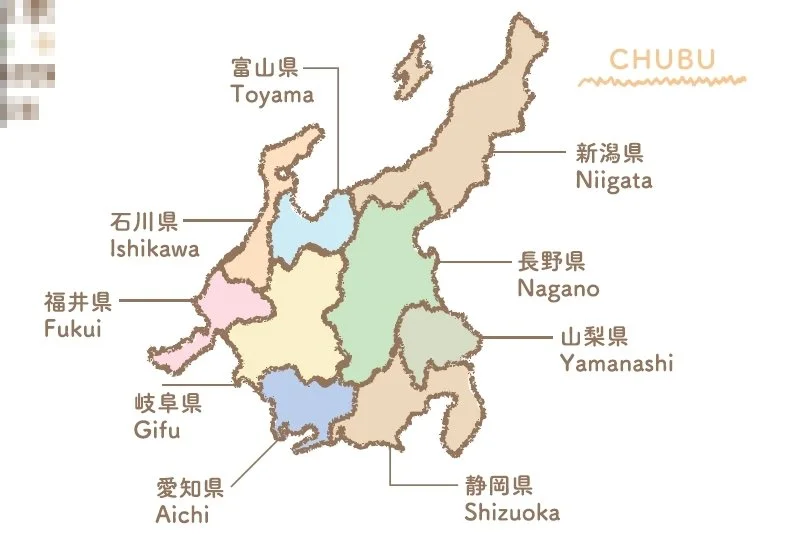Japan Chubu and Hokuriku Adventure—6 days, 5 nights
Taste seafood freshly caught from the Sea of Japan and see the mountains of Hokuriku draped in the fiery colours of autumn.
The Hokuriku Region lies to the northwest of Tokyo along the Sea of Japan, backing on to the spectacular snow-capped peaks of the Japanese Alps. This is one of Japan's most celebrated locations for seafood and gourmet dining, with Kanazawa in particular considered one of the very best places to eat in all Japan. Its majestic mountain landscapes and beautiful historic sites make it one of Japan's most popular locations for seeing the autumn colours, as do the natural thermal waters of its hot spring towns like Kaga Onsen.
Areas you would visit in this trip: Niigata, Nagano, Toyama and Ishikawa. Optional areas to visit include Yamanashi and Shizuoka where you can stay in a ryokan by Mt Fuji. Image Credit: Shutterstock
Day 1: Tokyo to Karuizawa <overnight at Karuizawa>
The journey to the west from Tokyo to Karuizawa, one of Japan's best known and oldest resort towns, takes you up into the first foothills of Nagano Prefecture. Nine of the ten tallest mountains in Japan can be found here, and Karuizawa itself sits at the foot of one of Japan's more active volcanos, Mt. Asama.
Before you're into the mountains proper you can take in the gentler autumnal scenery at Kumoba Pond, a natural pool famed as a beauty spot for visitors seeking out the vibrant reds, golds and yellows of the autumn forests.
Shiraito Falls at the foot of Mt. Fuji is considered one of Japan's most beautiful waterfalls and it's easy to see why. Its dramatic twenty metre cascade rushes out beneath thick tree cover and over moss-clad rocks so the river seems to be pouring from the forest itself. During the autumn months the brilliant colours of the leaves make the scene truly magical.
Autumn at Kumoba Pond. Enjoy a relaxing afternoon tea at Haruine Terrace nearby after visiting the pond. Image Credit: Shutterstock
Day 2: Karuizawa to Kanazawa <overnight at Kaga Onsen>
You'll travel from Karuizawa through the mountains and along the northwestern coast of Honshu to Kanazawa, a beautiful historic city famous for its temples, preserved Edo-era streets and traditional gardens, but also for its concentration of contemporary art, design and architecture museums. Before we explore the city, however, let's talk about where you'll spend the next two nights: Kaga Onsen.
Kaga Onsen lies southwest of Kanazawa along the coast, in the majestic mountainous region at the foothills of Mt. Hakusan, one of Japan's holiest mountains.. Here, four historic hot spring villages have grown together into one wonderfully varied onsen experience: each of the four villages has its own public bath, some of which have been brought completely up to date, and others have a more traditional style evocative of the late 19th century Meiji era.
Here you can enjoy the hot healing waters of the baths, moving from town to town and experiencing the unique atmospheres, traditional crafts and culinary specialities of each. The four villages themselves – Katayamazu Onsen, Awazu Onsen, Yamanake Onsen, and Yamashrio Onsen – each have their own unique attractions, from temples to lakeside views, and in one case, the world's oldest hotel still in operation, founded in 718 AD! These hot springs are said to have first been discovered by a Buddhist monk in the eighth century, and they're considered some of Japan's very best, with healing properties thought to aid with digestion, muscle pain and skin issues.
Many luxurious ryokans selections in Kanzawa, with delicious meals. Image Credit: Shutterstock
Day 3: Sightseeing at Kanazawa <overnight at Kaga Onsen>
After what will undoubtedly be a relaxing and restorative evening at Kaga Onsen, it's time to see the sights in Kanazawa. To begin, the bustling Omicho Market is as much a part of Kanazawa's history as it is of its famously high-quality cuisine. This large covered market has been in operation for over three centuries, and continues to sell fish and crab freshly caught in the Sea of Japan, which go on to supply the city's gourmet restaurants.
After the energy of the market, the Higashi Chaya district will restore a sense of tranquility. This is Kanazawa's historic tea house district and has offered visitors a place to relax and make merry for hundreds of years. You can visit the faithfully preserved Shima Chaya, which is now a museum, or have the teahouse experience yourself, entertained by geisha, at Kaikaro Teahouse. You'll also find an excellent selection of shops here, including some dedicated to a Kanazawa speciality: gold leaf.
One of Japan's Three Great Gardens is to be found in Kanazawa: the exquisitely beautiful Kenroku-en. It was constructed by the Maeda clan, who occupied much of the Hokuriku region during the Edo period, and its name – The Garden of Six Attributes – refers to its attempts to balance each of the ideal attributes of a garden: spaciousness, seclusion, artifice, antiquity, waterways, and panoramas.
Enjoying a relaxing day at Kanzawa: Left to right: Idlyiic Kenroku-en, Freshly caught crabs from the Japan Coast at Omicho Market, Peaceful afternoon stroll at Higashi Chaya District. Image Credit: Shutterstock, moonshine1219 and Kanazawakankoukyokai
The market may have given you a hint, but one of the best things about this region and its position between the coast and the mountains is the wide variety of fresh regional food on offer from land and sea alike. For those who are fond of meat, you'll find some excellent places to satisfy your inner carnivore, here are some suggestions:
Tsudumi is an izakaya that uses a range of locally sourced, seasonal ingredients to give visitors an authentic Kanazawa experience. Its speciality okonomiyaki features local Noto pork and Kaga vegetables, or you can go all in on the meat and enjoy high quality, local Noto-ushi steak grilled on hot stones from Mt. Fuji.
The title might have given it away, but this restaurant specialises in wagyu beef, precision-grilled over charcoal. This is considered one of the best places to sample wagyu beef in Kanazawa, and as it's kappo, the chef and his team will be close by as they prepare and talk you through one delicious dish after another.
For Teppanyaki (iron-griddle-cooked) cuisine, Rokkakudo, at the foot of Mount Utatsu is one of Kanazawa's very best. It lays a particular emphasis on the quality of its ingredients, and visitors can feast their eyes on local Noto beef, seasoned with hand-picked salt, pepper and oil, as it is prepared on a hot iron plate in front of them.
Day 4: Shirakawago → Takayama <overnight at Takayama>
The mountainous part of Gifu Prefecture is known as the Hida region, where all around you'll find thickly forested peaks and lush river valleys, vibrant in the reds and golds of autumn. Shirakawago is a traditional village and a UNESCO World Heritage Site, famous for its beautiful gassho-zukuri farmhouses and its spectacular surroundings in the Shogawa River Valley. The rooves of these farmhouses are built without the use of nails and were designed to create a large attic space suitable for the cultivation of silkworms, while withstanding the great weight of snow that falls during the winter months. Shirakawago comes to brilliant life during autumn, and the traditional wooden houses surrounded by the brilliant red and yellow forests are a spectacular sight.
Takayama Old Town will transport you back into feudal era Japan, with wonderfully preserved houses and narrow streets offering visitors a chance to experience life as it once was. Some of the shops and sake breweries here have been in business for hundreds of years, and there are even a number of homes that are open to visitors.
After a taste of historic urban life at Takayama, Hida folk village will transport you back to life as it once was in Japan's rural settlements. The buildings here have been brought together from the surrounding region to create an open air museum where you can see everything from the village head's house to logging huts. The traditional rooms are heated with their original open fires, making them a richly atmospheric and cosy autumn experience.
Left to right: The hida region draped in golds of autumn: Shirawago, Hida Folk Village and a sumptous hida-gyu sukiyaki to end the day. Image credit: Shutterstock and Tabelog
Day 5: Kamikochi <overnight at Kamikochi>
Kamikochi is one of the most breathtaking locations in the Japanese Alps, with snowy peaks visible along the horizon above the lush greens, reds and golds of the autumn forests, and the clear blue Azusa river flowing by beneath. Some of its most majestic spots include Taisho pond, which was formed by the eruption of Mt. Yake in 1915, shortly after the death of Emperor Taisho. From here, it's a short walk to the famous Kappa Bridge, a wooden suspension bridge that is the symbol of the Kamikochi region and a great place to enjoy the Azusa River while taking in views of the Hotaka Peaks beyond. If you enjoy hiking, Myojin Pond, in the upper Hotaka Shrine, surrounded by the thick mountain forests, is a spectacular sight in autumn, and has a wonderfully still and peaceful atmosphere.
After a day in the mountains, the Kamichochi Lemeista Hotel gives visitors the comfort of a luxury hotel while letting you commune with the mountain landscapes that surround it. Guests can enjoy its natural open air hot spring baths, or even stay in rooms with their own baths, with water piped directly from the hot springs. Looking over the peaks and forests of the Kamikochi region while its natural waters restore you is the ideal way to end a day of mountain exploring. Food lovers will enjoy the hotel's unique cuisine which uses local ingredients and French cooking techniques to produce speciality dishes.
Kappabashi at Kamikochi. Image Credit: retrp
Day 6: Kamikochi to Tokyo
As you travel back to Tokyo you can reflect on what has been a truly epic journey between the Sea of Japan and the soaring peaks and verdant valleys of the Japanese Alps, all brightly carpeted in the red, yellow and golden hues of autumn. We love our guests to leave Japan feeling newly enriched, with sights, sensations, and experiences that they can carry with them. After your experiences sampling Japan's finest food, its freshest fish, and the delightful pace of Onsen town life, we're sure you'll have plenty to take home with you!










